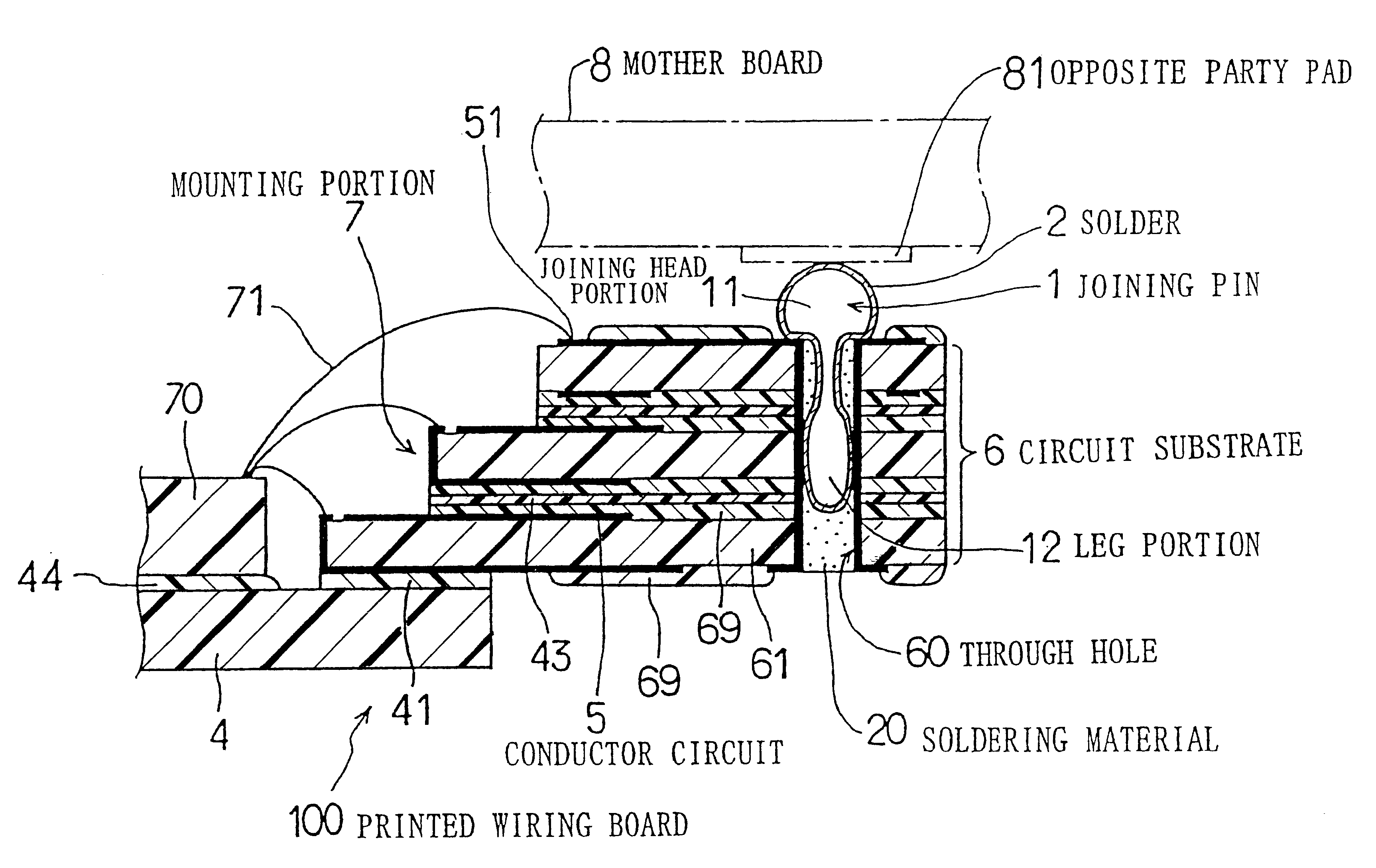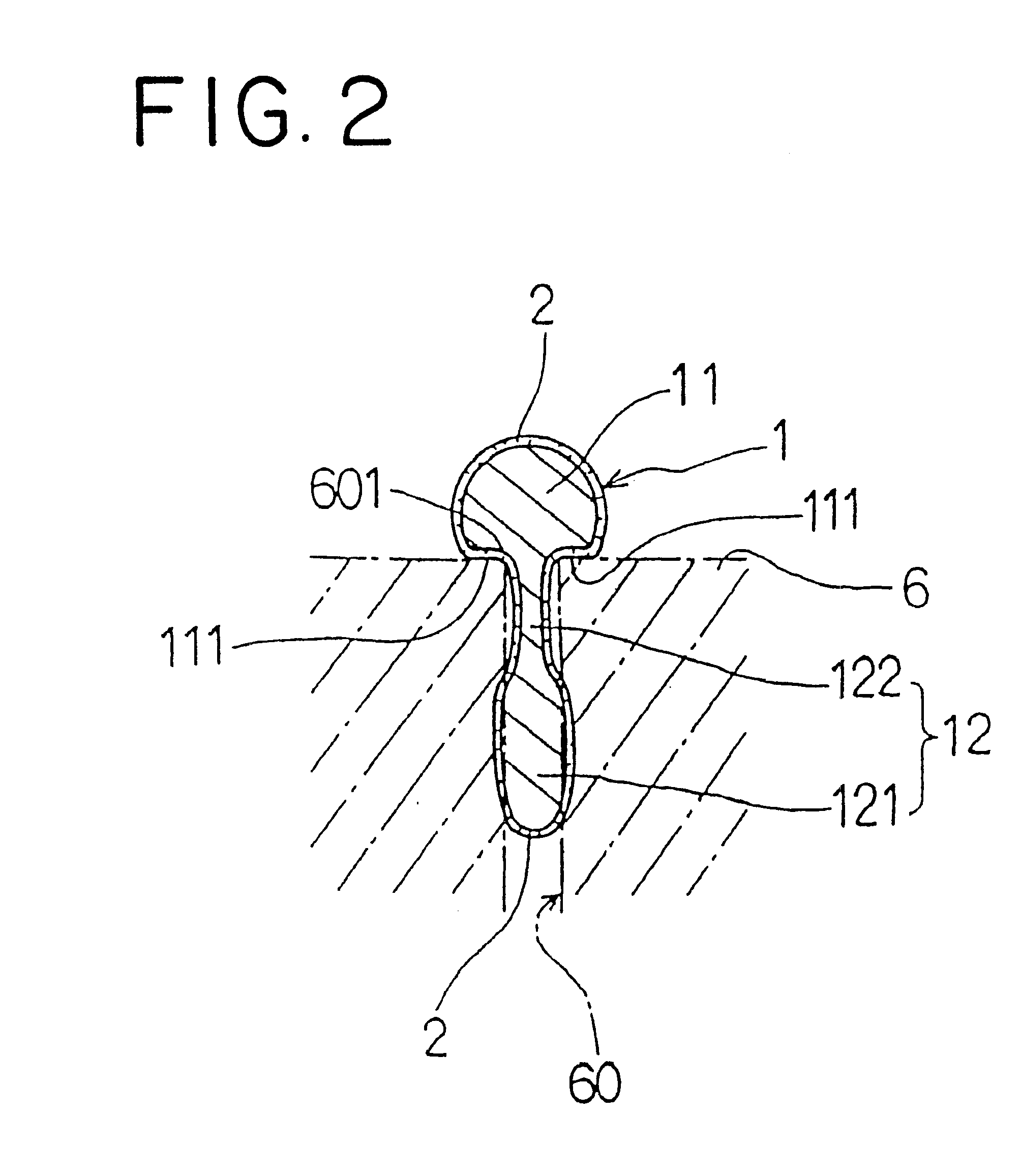Printed wiring board with joining pin and manufacturing method therefor
a printing board and joining pin technology, applied in the direction of electrical apparatus construction details, sustainable manufacturing/processing, final product manufacturing, etc., can solve the problems of difficult to secure a sufficient space and conventional printed wiring boards, and achieve the effect of high density wiring structures
- Summary
- Abstract
- Description
- Claims
- Application Information
AI Technical Summary
Benefits of technology
Problems solved by technology
Method used
Image
Examples
embodiment mode example 1
An example of a printed wiring board in an embodiment mode in the present invention will be explained next by using FIGS. 1 to 10.
As shown in FIG. 1, the printed wiring board 100 in this example has a circuit substrate 6 having a conductor circuit 5, a through hole 60, and a joining pin 1 inserted into the through hole 60.
The joining pin 1 is manufactured by using a material unmelted at a heating temperature when the joining pin 1 is soldered and joined to an opposite party pad 81 on a mother board 8. For example, the joining pin 1 is manufactured by using covar, phosphor bronze, etc. The joining pin 1 is constructed by an enlarged joining head portion 11 and a leg portion 12. The joining head portion 11 is greater in diameter than an opening diameter of the through hole 60 the leg portion 12. The joining leg portion provides and forms a joining portion for connection to the opposite party pad 81. The joining head portion 11 comprises an enlarged end section which provides an enlarg...
embodiment mode example 2
In this example, as shown in FIGS. 11 and 12, a groove 112 for extracting the air is formed in a lower portion 111 of the joining head portion 11 of the joining pin 1.
As shown in FIG. 12, four grooves 112 are formed in a radiating shape from a central portion of the lower portion 111 toward its exterior. Each of the grooves 112 has 0.1 mm in width and 0.05 mm in depth.
A surface of the joining pin in this example is covered with unillustrated solder.
The other constructions are similar to those in the embodiment mode example 1.
In this example, as shown in FIG. 11, when a melted soldering material 20 is flowed into the through hole 60, the air existing within the through hole 60 is discharged outward through a portion between an opening portion 601 of the above through hole 60 and each of the grooves 112. Therefore, no air is sealed within the through hole 60. Accordingly, the entire interior of the through hole 60 can be filled with the soldering material 20 without any clearance.
Effe...
embodiment mode example 3
In this example, as shown in FIGS. 13 and 14, a leg portion 12 of the joining pin 1 has plural projecting portions 125 widened in a radiating shape. Each of the projecting portions 125 has a maximum diameter of 0.35 mm slightly greater than a diameter of the through hole 60.
Similar to the embodiment mode example 2, a groove 112 is formed in a joining head portion 11 of the joining pin 1. As shown in FIGS. 15 and 16, a surface of the joining pin 1 is covered with solder 2. The other constructions are similar to those in the embodiment mode example 1.
In this example, as shown in FIGS. 13 and 14, the plural projecting portions 125 are formed in the leg portion 12 of the joining pin 1. Therefore, as shown in FIGS. 15 and 16, when each projecting portion 125 is inserted into the through hole 60, both ends of the projecting portion 125 are inserted into the through hole 60 while both the ends of the projecting portion 125 locally press against a wall face of the through hole 60, since the...
PUM
 Login to View More
Login to View More Abstract
Description
Claims
Application Information
 Login to View More
Login to View More - R&D
- Intellectual Property
- Life Sciences
- Materials
- Tech Scout
- Unparalleled Data Quality
- Higher Quality Content
- 60% Fewer Hallucinations
Browse by: Latest US Patents, China's latest patents, Technical Efficacy Thesaurus, Application Domain, Technology Topic, Popular Technical Reports.
© 2025 PatSnap. All rights reserved.Legal|Privacy policy|Modern Slavery Act Transparency Statement|Sitemap|About US| Contact US: help@patsnap.com



